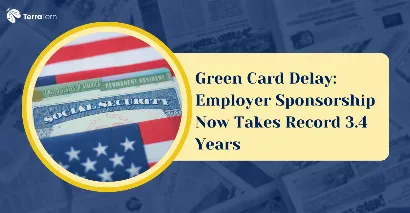Key Highlights
The United States is scrambling to cope with an accelerating problem in an ever more globalised world where a nationwide mentality and capacity to lure and keep the best talent have become an inherent part of domestic economic well-being. The most recent report issued by the Cato Institute highlights a sobering fact: the average employer-sponsored green card has taken an all-time high of 3.4 years, or 1,256 days, to process. That is an appalling 78 per cent rise compared to 2016, when the average patient waited a relatively shorter amount of time at 1.9 years. The repercussions of this bureaucratic loophole are both long-term and widespread, impacting hundreds of thousands of skilled labourers and their families, as well as abolishing the competitive advantage of America in the global market.
Such a drastic increase in delays in processes is not a unique problem but a product of a systematic malfunction. The system of immigration in the U.S., characterised by ageing policies, inadequate funding and backlogs that are obscene, has not had much success in adapting to the current requirements. To foreign professionals who had used their lives to develop careers and add value to the U.S. economy, the issue has become a confusing and, in most cases, demoralising odyssey due to the long process of acquiring permanent residency, which used to be a straight pathway.
It is apparent in this blog post that due diligence is traced to help find the real causes of such delays, the effects it has on individuals and the economy, and the current urgency to have a more streamlined immigration process that it is hoped can cement the future of America as a major draw to world talent.
The Escalating Crisis: A Deeper Look at the Delays
The existing U.S. immigration system may be compared to a road jam that is so big and crowded with no indication of its end. These figures offer a gloomy depiction of the state of affairs; since 2016, the number of pending employer-sponsored cases at the Department of Labour (DOL) and the Department of Homeland Security (DHS) has increased more than twofold, surpassing half a million cases. This is among a greater area of concern, and across the board, U.S. Citizenship and Immigration Services (USCIS) handles 11.3 million pending immigration applications.
The main cause of such delays is the sheer number of applications and the bureaucratic system itself, which has not really adapted to the now global workforce. A sequence of procedures that used to take place has now turned into a multi-year process, each step of which extends the overall wait time by a substantial amount. This has a snowball effect, with one delay leading to delays in all other stages, entangling the applicants in a state of legal limbo. The issue is so evident that close to 90% of the job applicants facilitated by employers are already residing in the U.S. and work on temporary permits such as the H-1B to sustain their legal status pending green card application approval. The need for a temporary work visa is a necessity that is applied de facto, and this serves to complicate and make life doubly uncertain in an already very difficult experience.
Also Read: US Visitor Visa B1/B2
Breaking Down the Delays: A Step-by-Step Analysis
The green card process consists of a number of important steps, and as far as the analysis by the Cato Institute shows, it has deteriorated in all aspects. A breakdown in the increase in processing time on each step since 2016 is as follows:
Determinations in Prevailing Wage
The first step is where the DOL comes up with a fair wage to pay for the position, depending on its job type and geographic location, which has dramatically increased in processing time. Between 2016 and 2019, this step on average took 76 days, or around 2.5 months. The wait is now over 187 days, or 6.1 months, on average, more than doubling the figures today compared to the pre-COVID situation.
-
The Bridge to Labour Certification: The delay of this first-step certification forms a big bottleneck at the gate itself. Obtaining a prevailing wage has become a mandatory necessity to enable an employer to make the next most important step, which is the U.S. worker recruitment process. Such an initial delay thereby creates a bad precedent and advances all other filings, further skewing the overall aggregate length in years.
Labour Certification (PERM)
Labour Certification, or PERM (Program Electronic Review Management), aims at making sure that the employer has tried to find a suitable U.S. employee to fill the vacancy and that the immigrant worker will not send home a native employee. This process is one of the principal causes of the backlog nowadays. In 2016, the processing time was an average of 180 days, which is 6 months. That wait has come to almost triple to 483.4 days, or just under 16 months.
-
An Increasing Backlog: The vast expansion in PERM processing time is directly attributed to the sheer volume of applications, and also because of the bureaucratic avenue of numerous pages of documentation and forms. The massive number of cases filed has stretched the personnel of the DOL to bring about an expansive backlog, with a resulting rise towards the historical max of wait times. This stage by itself can easily extend the whole green card process by more than a year.
Form I-140: Employer Petition
A labour certification can be approved, after which the employer will submit an Immigrant Petition for Alien Worker, or Form I-140, to the DHS. This form establishes whether the worker is skilled and whether the employer can afford the proposed salary amount. It has also slowed the amount of time it takes to process this step, which currently takes 234 days as compared to 180 days in 2016. Although there is a better opportunity to speed up the process by paying a fee of 2805 in order to use premium processing, there is a disadvantage in remembering that premium processing will only expedite one step in the process, not the overall timeline.
-
The Unavoidable Backlogs: As much as the premium processing is available as a temporary solution, the same is of little help in normalising the other sections of the system that have the backlogs. Interestingly, the applicant is forced, nonetheless, to wait until the preceding PERM certification and the following green card application are in progress, so even with the costly extra, there will be a painfully long waiting time involved.
Also Read: Intracompany Transfer Visa USA
Green Card Application (Form I-485)
The final stage is the filing of Form I-485, the application to adjust status to a lawful permanent resident. This includes a background check, a medical screening, and a final check to confirm that the original job offer is still valid. The average processing time for this final step has increased from 165 days in 2016 to 210 days today.
The Human and Economic Toll
The years-long losses are not just a bureaucratic nuisance; they have a deep human and economic impact. The wait leaves the future uncertain for immigrant workers. They find themselves restricted from changing employers, negotiating pay increases and even opening a new business, thereby rendering their career life to the sponsoring employer over the years. Such immobility may hamper innovation and deny talented people a chance of achieving their potential. Moreover, the waiting strains the mental well-being, and applicants and their families exist in constant fear that they may receive a denial of an application, hence deportation.
Economically, the delays jeopardise the position of America as a leader in the world. With the realisation of the importance of skilled immigrants, other nations have developed more effective and accommodating systems of immigration. Since it takes a Canadian or European engineer or scientist weeks or months to receive a permanent residency permit, a wait of 3.4 years in the U.S. becomes a related downside. With America losing their global competition in terms of talent, as the Cato Institute warns, America has the prospect of losing the global talent competition.
The present system compels the best and the brightest to go abroad, denying the US economy the innovation and growth that immigrants have been known to bring. This is especially troublesome when it comes to highly skilled immigrants in countries such as India and China, who must contend with not only these backlogs but also country-specific quotas on visas, making the waiting times of some Indian applicants under some types even reach into the decades, possibly a lifetime.
Also Read: How Many Types of Visas are in the USA? New Full Expert Guide
Conclusion
The prolonged delays in green card processing by the employers are unprecedented and a vital topic that should be addressed without any delay. They are merely a sign of a failing system with obsolete regulatory infrastructure, limited resources and an increasing backlog. The human toll is crushing, not only leaving skilled professionals in a state of confusion but also depriving them of maximising their contribution to society. Economically, the competitiveness of the country is threatened, as talent opts to find friendlier shores.
To effectively address this crisis, there is a need to overhaul the immigration system as a whole with streamlined aspects placed upon efficiency and a reduction in bureaucratic elements that are really not necessary. Modernising its policy towards legal immigration will help the U.S. reclaim the role of global leader and allow it to avoid the problem of brain drain not only in the fields of science and technology but also in other spheres related to economics and business. To know more, visit TerraTern now!








